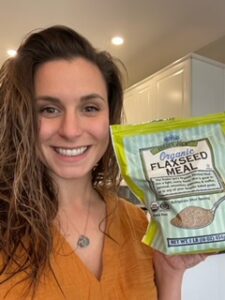
Para leer en Español, por favor haga clic aquí
Fall presents the perfect opportunity to hit the reset button on our health and wellness goals. As kids’ lunchboxes make their return and busy schedules fill our calendars, there’s no better time to infuse your lunch with an assortment of nutrient-packed superfoods. Eating a balanced and healthy lunch can help you sustain your energy throughout the day, avoiding an afternoon slump.
Cooper University Health Care’s team of registered dietitians work with adult and pediatric patients to help them manage chronic conditions, improve their health, and reach their wellness goals.
We asked a few of these food and nutrition experts to share their go-to superfoods and recipes they can’t live without. We hope that this list inspires you to add a few new healthy foods to improve your lunches and help keep sustained energy throughout your busy day.

Josie Raum, MS, RD, CSOWM
Flaxseed
Josie Raum, MS, RD, CSOWM
Bariatric Dietitian
Flaxseed is as close to it gets when it comes to a “superfood.” It is a great source of antioxidants, fiber, protein, and healthy fats, such as omega-3s. Flaxseed is a great addition to anyone’s diet because of its heart-healthy benefits.
You can add flax meal, which you can find at most grocery stores, to almost any food without altering its taste or texture. I add it to smoothies and mix it into yogurt, oatmeal, and pancake/waffle mix. I have even mixed it up with mayo or mustard to put on my kids’ sandwiches, and they have no idea.
Plain Greek Yogurt
Elizabeth Messina, RD, MBA
Lead Clinical Dietitian
I use plain, unflavored, nonfat Greek yogurt every day. It’s high in protein and calcium and low in fat and sodium. I mix it with fruit for a quick breakfast or snack (or dessert!), and I also mix Greek yogurt with mustard and spices as a delicious and healthy topping for grilled salmon. It’s a very versatile food and a mainstay of my diet.

Caitlyn Devlin, MS, RDN
Avocados
Caitlyn Devlin, MS, RDN
Lead Clinical Dietitian
I love avocados for their unique texture that complements many dishes. Avocados are an excellent source of potassium, healthy fat, and fiber. They help lower cholesterol levels and blood pressure – making them a heart-healthy food. They also support gut health by improving digestion while keeping you more satisfied after meals. I love adding avocados to smoothies, salads, and quesadillas.
Blueberries
Maryann Codd, MS, RD, CDE
Pediatric Dietitian
I work with children, and many of my patients experience reflux, abdominal pain, or constipation. I frequently recommend blueberries to both adults and children – it is my favorite food! Blueberries are sweet, low in calories, nutritious, and packed with vitamins and minerals, including fiber and vitamin C. They are rich in antioxidants, which protect your body from free radicals that may contribute to the aging process and diseases such as cancer. Blueberries are also very versatile and can be used in smoothies or muffins or as a topping for yogurt and hot or cold cereal.
Eggplant
Anne Starr, MS, RD
Program Nutritionist
Eggplant is one food I always recommend to my patients. (Fun fact – while it is often considered a vegetable, eggplant is technically a fruit.) While eggplants with a deep purple skin are most common, they can be white, red, green, pink or orange and even have striped skin. They are also affordable and available year-round.
Eggplants are rich in antioxidants and support digestion. They are also high in natural plant chemicals called polyphenols, which may help cells do a better job of processing sugar if you have diabetes. From smoky Middle Eastern baba ganoush and Italian eggplant parmigiana to spicy Chinese stir-fries and stuffed Turkish dishes, eggplant recipes show up in cuisines from all over the globe. One of my favorite dishes is eggplant caponata. I love this dish because it is hearty and easy to prepare. You can get the recipe by clicking here.
Turkey Sticks
Sandra Vasquez, MS, RD, CSOWM
Bariatric Dietician
My favorite snack would have to be turkey sticks. They are a great source of protein, low in calories, and delicious. They are a perfect on-the-go snack or a wonderful addition to your next charcuterie board. I like cutting them into 1-inch pieces and adding them to my lunch box with some crackers, low-fat cheese, and fruit for a quick meal or snack.

Deanne P. Walther, RD
Easy No-Bake Energy Bites
Deanne P. Walther, RD
Inpatient Clinical Dietitian
These no-bake energy bites are easy to prepare and delicious! Packed with oats, peanut butter, coconut, flaxseed, and a few other tasty ingredients, these are great as a quick breakfast or when I need a midday, energy-boosting snack. I like to make a batch and pop them in the freezer. They last longer and are still easy to eat when frozen. You can get the recipe by clicking here.
Nuts
Linda Goldsmith, MA, RD, CSO, TTS
Outpatient Oncology Dietitian
Nuts are my go-to superfood! As with fruits and vegetables, you should eat a variety of nuts. All nuts are high in fiber and healthy fats, but different nuts have different micronutrients. You can grab a handful (about ¼ cup) as a snack or add them to yogurt, oatmeal, or salads. Nut butters can be added to smoothies or sandwiches, and vegans can substitute cashew “cream” for dairy products in many dishes. Need a quick fix for your sweet tooth? Cut open some dates and add a dollop of almond or mixed nut butter. Keep them in the fridge for a grab-and-go snack.
Thank you to our registered dietitians for sharing their nutritional expertise to help patients make personalized and positive lifestyle changes.
If you have questions about changing your current diet, speak to your primary care provider. If you need a primary care provider, Cooper University Health Care has many to choose from. Call 800.8.COOPER (800.826.6737) or use our online form to make an appointment.
Superalimentos a la hora del almuerzo: su guía para aumentar la energía al mediodía
El otoño presenta la oportunidad perfecta para presionar el botón de reinicio de nuestros objetivos de salud y bienestar. A medida que regresan las loncheras de los niños y las apretadas agendas llenan nuestros calendarios, no hay mejor momento para infundir a su almuerzo una variedad de superalimentos llenos de nutrientes. Comer un almuerzo equilibrado y saludable puede ayudarte a mantener tu energía durante todo el día, evitando un bajón por la tarde.
El equipo de dietistas registrados de Cooper University Health Care trabaja con pacientes adultos y pediátricos para ayudarlos a controlar afecciones crónicas, mejorar su salud y alcanzar sus objetivos de bienestar.
Les pedimos a algunos de estos expertos en alimentación y nutrición que compartieran sus superalimentos y recetas sin los cuales no pueden vivir. Esperamos que esta lista lo inspire a agregar algunos alimentos nuevos y saludables para mejorar sus almuerzos y ayudarlo a mantener energía sostenida durante su ajetreado día.
Semilla de lino
Josie Raum, MS, RD, CSOWM
Dietista bariátrica
La linaza es lo más parecido a un “superalimento”. Es una gran fuente de antioxidantes, fibra, proteínas y grasas saludables, como los omega-3. La linaza es una gran adición a la dieta de cualquier persona debido a sus beneficios para la salud del corazón.
Puedes agregar harina de lino, que puedes encontrar en la mayoría de los supermercados, a casi cualquier alimento sin alterar su sabor o textura. Lo agrego a batidos y lo mezclo con yogur, avena y mezcla para panqueques y gofres. Incluso lo he mezclado con mayonesa o mostaza para ponerlo en los sándwiches de mis hijos y ellos no tienen idea.
Yogur griego natural
Elizabeth Messina, RD, MBA
Dietista clínico principal
Utilizo yogur griego natural, sin sabor y sin grasa todos los días. Tiene un alto contenido de proteínas y calcio y un bajo contenido de grasas y sodio. Lo mezclo con fruta para un desayuno o merienda rápido (¡o postre!), y también mezclo yogur griego con mostaza y especias como aderezo delicioso y saludable para el salmón a la parrilla. Es un alimento muy versátil y un pilar de mi dieta.
Aguacates
Caitlyn Devlin, MS, RDN
Dietista clínico principal
Me encantan los aguacates por su textura única que complementa muchos platos. Los aguacates son una excelente fuente de potasio, grasas saludables y fibra. Ayudan a reducir los niveles de colesterol y la presión arterial, lo que los convierte en un alimento saludable para el corazón. También apoyan la salud intestinal al mejorar la digestión y lo mantienen más satisfecho después de las comidas. Me encanta agregar aguacates a batidos, ensaladas y quesadillas.
arándanos
Maryann Codd, MS, RD, CDE
Dietista pediátrico
Trabajo con niños y muchos de mis pacientes experimentan reflujo, dolor abdominal o estreñimiento. Con frecuencia recomiendo los arándanos tanto a adultos como a niños: ¡es mi comida favorita! Los arándanos son dulces, bajos en calorías, nutritivos y repletos de vitaminas y minerales, incluidas fibra y vitamina C. Son ricos en antioxidantes, que protegen el cuerpo de los radicales libres que pueden contribuir al proceso de envejecimiento y a enfermedades como el cáncer. Los arándanos también son muy versátiles y se pueden utilizar en batidos o muffins o como aderezo para yogur y cereales fríos o calientes.
Berenjena
Anne Starr, MS, RD
Nutricionista del programa
La berenjena es un alimento que siempre recomiendo a mis pacientes. (Dato curioso: si bien a menudo se considera una verdura, la berenjena es técnicamente una fruta). Si bien las berenjenas con piel de color morado oscuro son las más comunes, pueden ser blancas, rojas, verdes, rosadas o naranjas e incluso tener la piel rayada. También son asequibles y están disponibles durante todo el año.
Las berenjenas son ricas en antioxidantes y favorecen la digestión. También tienen un alto contenido de sustancias químicas vegetales naturales llamadas polifenoles, que pueden ayudar a las células a procesar mejor el azúcar si se tiene diabetes. Desde el ahumado baba ganoush del Medio Oriente y la berenjena italiana a la parmesana hasta los picantes salteados chinos y los platos turcos rellenos, las recetas de berenjena aparecen en las cocinas de todo el mundo. Uno de mis platos favoritos es la caponata de berenjena. Me encanta este plato porque es abundante y fácil de preparar. Puedes conseguir la receta haciendo clic aquí.
palitos de pavo
Sandra Vásquez, MS, RD, CSOWM
Dietista bariátrica
Mi bocadillo favorito tendrían que ser los palitos de pavo. Son una gran fuente de proteínas, bajas en calorías y deliciosas. Son un refrigerio perfecto para llevar o una maravillosa adición a su próxima tabla de embutidos. Me gusta cortarlos en trozos de 1 pulgada y agregarlos a mi lonchera con algunas galletas saladas, queso bajo en grasa y fruta para una comida rápida o un refrigerio.
Bocaditos energéticos fáciles sin hornear
Deanne P. Walther, RD
Dietista clínico para pacientes hospitalizados
¡Estos bocados energéticos sin hornear son fáciles de preparar y deliciosos! Llenos de avena, mantequilla de maní, coco, linaza y algunos otros ingredientes sabrosos, son excelentes como desayuno rápido o cuando necesito un refrigerio al mediodía que aumente la energía. Me gusta hacer un lote y meterlos en el congelador. Duran más y aún son fáciles de comer cuando están congelados. Puedes obtener la receta haciendo clic aquí.
Nueces
Linda Goldsmith, MA, RD, CSO, TTS
Dietista de Oncología Ambulatoria
¡Las nueces son mi superalimento preferido! Al igual que con las frutas y verduras, conviene comer una variedad de frutos secos. Todos los frutos secos son ricos en fibra y grasas saludables, pero cada fruto seco tiene diferentes micronutrientes. Puedes tomar un puñado (aproximadamente ¼ de taza) como refrigerio o agregarlos al yogur, la avena o las ensaladas. Se pueden agregar mantequillas de nueces a batidos o sándwiches, y los veganos pueden sustituir los productos lácteos por “crema” de anacardos en muchos platos. ¿Necesita una solución rápida para su gusto por lo dulce? Corte algunos dátiles y agregue una cucharada de mantequilla de almendras o nueces mixtas. Guárdelos en el refrigerador para un refrigerio para llevar.
Gracias a nuestros dietistas registrados por compartir su experiencia nutricional para ayudar a los pacientes a realizar cambios de estilo de vida positivos y personalizados.
Si tiene preguntas sobre cómo cambiar su dieta actual, hable con su proveedor de atención primaria. Si necesita un proveedor de atención primaria, Cooper University Health Care tiene muchos para elegir. Llame al 800.8.COOPER (800.826.6737) o utilice nuestro formulario en línea para programar una cita.

So interesting!
Good article eat most.